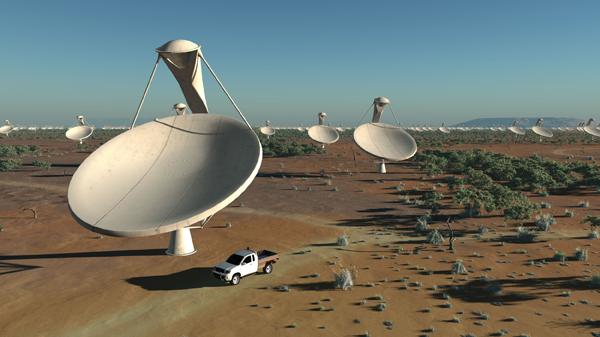ASTRON and IBM to explore origins of the universe
April 2, 2012
IBM and ASTRON, the Netherlands Institute for Radio Astronomy, have announced an initial 32.9 million EURO, five-year collaboration to research extremely fast, but low-power exascale computer systems for the international Square Kilometre Array (SKA).
The SKA is an international consortium to build the world’s largest and most sensitive radio telescope. Scientists estimate that the processing power required to operate the telescope will be equal to several millions of today’s fastest computers.
The target is to read, analyze and store one exabyte of raw data per day — two times the entire daily traffic on the World Wide Web.
ASTRON is one of the leading scientific partners in the international consortium that is developing the SKA. Upon completion in 2024, the telescope will be used to explore evolving galaxies, dark matter, and the Big Bang.
The next generation of large scientific instruments, of which the SKA is a key example, requires a high-performance computing architecture and data transfer links with a capacity that far exceeds current state-of-the-art technology.
To solve this unprecedented challenge, ASTRON and IBM scientists in the Netherlands and Switzerland have launched an initial five-year collaboration called DOME, named for the protective cover on telescopes and the famous Swiss mountain.
DOME will investigate emerging technologies for large-scale and efficient exascale computing, data transport and storage processes, and streaming analytics that will be required to read, store and analyze all the raw data that will be collected daily. Scientists from both organizations will collaborate at the newly established ASTRON & IBM Center for Exascale Technology in Drenthe, the Netherlands.
Scientists at ASTRON and IBM will investigate advanced accelerators and 3D stacked chips for more energy-efficient computing. They will also research novel optical interconnect technologies and nanophotonics to optimize large data transfers, as well as high-performance storage systems based on next-generation tape systems and novel phase-change memory technologies.
Introducing the SKA, the world’s largest radio telescope
A global community of astronomers from more than 20 countries is setting out to build the Square Kilometre Array (SKA), the world’s largest radio telescope.
This extremely powerful survey telescope will have millions of antennas to collect radio signals, forming a collection area equivalent to one square kilometer but spanning a huge surface area — more than 3000 km wide, or approximately the width of the continental U.S. The SKA will be 50 times more sensitive than any former radio device and more than 10,000 times faster than today’s instruments.
The SKA is expected to produce a few exabytes of data per day for a single beam per one square kilometer. After processing this data, the expectation is that between 300 and 1500 petabytes of data per year need to be stored. In comparison, the approximately 15 petabytes produced by the large hadron collider at CERN per year of operation is approximately 10 to 100 times less than the envisioned capacity of SKA.
Plans for the location of the SKA are still to be finalized, with a decision expected in 2012. Australia and South Africa are the two remaining options, where it would be possible to install the millions of antennas required for receiving the very weak signals from the universe.
